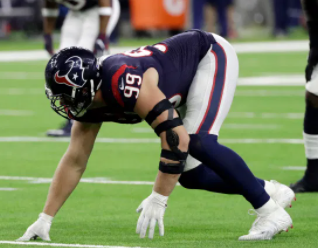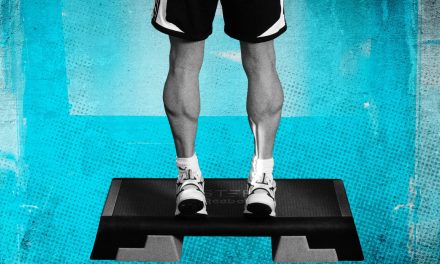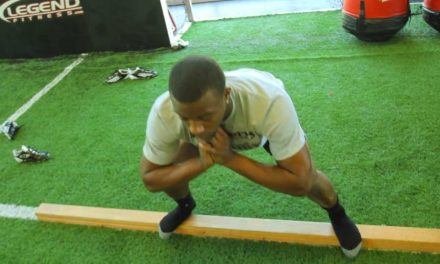We might never be able to completely prepare our athletes for all of the awkward ways they land and move during a game but we can try to simulate as many situations as possible. On top of the feet landing in a variety of directions, the feet can land flat-footed, on the ball of the foot, or sometimes on the heel. Ultimately our job is to make sure the body can move explosively in any foot position while also limiting injury risk. The following information details different ways of thinking about the feet’s role in athleticism and some of the ways the feet can be trained to produce better football players.
CENTER OF MASS’S EFFECT ON THE FEET
The Center of Mass is the balancing point of the body and the feet will signal where that balancing point is located at any time. To feel how the Center of Mass affects the feet, stand upright with your shoulders over top of your hips. While standing in this position, you will feel even pressure throughout the entire foot. The reason why is because the Center of Mass is sitting right around the belly button.
By just moving the shoulders a fraction of an inch, the Center of Mass will move and the body will compensate for the shift. To have the athletes feel their Center of Mass move, have them stand upright (they should feel even pressure) and then move their shoulders in different directions. While they are moving their shoulders, they will feel the pressure in the feet move in the same direction of their shoulders.
Teaching athletes to feel the Center of Mass in their feet is vitally important because if the Center of Mass is not where it is supposed to be, an athlete’s current movement and their next movement will be compromised. The Center of Mass is one of the key ingredients that helps determine the proficiency and efficiency of the next movement. In the pictures below, the person to the left will feel even pressure on their feet since their Center of Mass is sitting in the Anatomically Correct Position. For the person to the right, they will feel more pressure in the front half of their foot since their Center of Mass has moved forward.
In terms of football stances and starts, players have to know where their Center of Mass is located because it will let them know what they are set up to do next. Tailbacks and Linebackers have to set their Center of Mass to prepare for moving forward or sideways. If they do not know where they will move next, they should have more even pressure on their feet even though in a Universal Athletic Position, the weight will be slightly more in the ball of the foot. In a zone stance, a wide receiver’s front foot pressure should be on the ball of the foot so they can take off like a sprinter. In a man stance, the receiver’s front foot pressure should be more even because their initial movement will be sideways or diagonal. A good rule of thumb is if you know which way you are going then you should move the Center of Mass that direction to put pressure on the foot in that direction. If you are a reaction player (open field tackling or blocking, baseball fielder, basketball defender), then you should have a more balanced Center of Mass so there is more even pressure on your feet so you can move forward, backward, or laterally.
For the pictures below, you can see:
o Serena Williams shoulders are over top of her hips so she has perfect balance. This will allow her to not only hit the ball but it will allow her to recover and be able to prepare for her opponent’s return.
o For the 2 sprinters, the one on the left has a balanced Center of Mass (even though it has moved forward), where the sprinter on the right will have a Center of Mass that is too far forward and will make him run incorrectly.
o For the volleyball players, the girl in the middle’s Center of Mass is too far forward which will cause the pressure in her feet to be too far forward which will make it hard for her to move laterally to get a ball.
o For the 2 drawings of men doing the vertical jump, the person on the left will be able to jump higher because his Center of Mass is not being pushed forward. The person on the right will jump diagonally and up since their Center of Mass is too far forward.
TRIPLE EXTENSION
In the weight room, we should constantly be practicing jumping. This is done by doing explosive strength exercises that require triple extension and the kinetic chain for the lower body is essential for creating power. When jumping or getting into triple extension the following order of events has to occur even though the events will sometimes be occurring simultaneously. After the athlete bends their knees to “load” their limbs, the order will be:
- The pressure of the foot goes to the ball of the foot and the heel starts lifting off of the ground
- The ankles extend and the lower leg tries to have a straight line between the toes and the shin
- The legs straighten at the knee joint to get through the entire range of motion for the knee joint
- The glutes squeeze and pinch as tight as possible
- The hips hyperextend (hips go in front of the chest)
If any part of this process goes in the wrong order or is incomplete, the athlete will not be as strong or explosive as they should be. An example of how doing things in the wrong order can affect the amount of power generated, think about jumping if someone straightened their legs first and then got up on their toes. They would not generate any power except what the calves could produce.
The part of this process that falls short for most athletes is the feet do not get completely involved and this is especially true for KB Swings. I constantly see athletes do explosive exercises where their heels do not come off the ground which will cause them to lift less weight and it will not teach their motor neurons how to fire correctly and in the correct order. For the following exercises, they are a great way to teach the transition from a flat footed position to on the ball of the foot:
- Power/Hang Cleans
- High Pulls
- Deadlift Jumps
- DB/Kettlebell Swings
- Medicine Ball Throws
- High Hurdle Jumping
- Box Jumps
My favorite exercises for the feet are when the foot has to rock back and forth between flat footed and on the ball of the foot multiple times. In the following exercises, the foot is flat, then comes to the balls of the feet for the “clean” portion, becomes flat again for the catch, and then has to go to the balls of the feet for Push Press. Having to go from the Universal Athletic Position to triple extension, and then repeat is a great way to teach the motor units in the feet to activate properly.
To simplify Clean-Squat-Press, you can also do it with a landmine:
Landmine Clean & Press With Attachment
2-Arm Landmine Clean (After the initial clean movement, the athlete can push press the bar)
CHANGING FOOT ANGLES FOR LOWER BODY STRENGTH EXERCISES
When doing strength exercises, athletes can point their feet forward (regular feet), inside (pigeon feet), and outside (duck feet).
Pointing the feet in different directions will determine which motor units will be activated and how much stress will go through certain muscle fibers and joints. Instead of just doing the exercise with the regular feet each time, some exercises can use all three positions. Some of the following exercises can be done with different foot positions:
RDL & Good Mornings: Point the toes forward, in, and out.
Calf Raises: Point the toes forward, in, and out.
Sumo Squats: After spreading your feet widely, point the toes outwards to put more pressure through the adductors and the inside of the thigh.
Curtsy Lunges: In this exercise, the foot stays in position and then the body rotates around it instead of the body staying in place and the foot rotating.
USING THE FEET TO FIX SQUAT FORM
When doing any type of lower body exercise, the knees have to stay in line with the toes or there is an increased risk of knee and ankle injuries. This is especially the case for women because their hips are usually much wider than their knees but for men, usually the knees are set directly under the hips. The following picture shows how the knees should be positioned while squatting:
One of the problems we all face is that our young and weak athletes have a hard time keeping their knees in line with their toes because of their strength and flexibility deficiencies. This problem is very apparent when they are trying to lift a lot of weight. The best way to fix this problem is not by telling the athletes to push their knees out. The best way is to position the feet in a way that forces the knees to align with the toes. The following video does a great job of describing how to set the feet to protect the knees while creating proper movement patterns: Video On Spreading The Floor
USING THE FEET TO LIMIT INJURY RISK
BULGARIAN SQUATS
For most people, the natural way to place the elevated foot on the bench is incorrect. If you look at the pictures above, the picture on the left is how I see most people place their elevated foot. The reason why I have my athletes place their elevated foot like the picture on the right is because it takes pressure off the top of the foot. The top of the foot is very sensitive and placing the foot correctly can alleviate unneeded pressure through the foot and ankle. Below are some other creative ways to decrease the pressure in the top of the foot:
SIDE LUNGES
The two most common mistakes that athletes make on Side Lunges is they allow their bent knee to go past their toes and they allow their trail leg foot to drag across the ground. Most coaches make sure that their athlete’s knees do not go past the toes (because they coach that same technique for Squat) but most do not correct the mistake of allowing the trail leg foot to drag across the ground. In the picture on the right, the athlete has both soles of their shoes on the ground. For the picture on the left, the sole of the trail leg shoe is up and the inside of the foot will drag along the ground. When this occurs this puts a lot of pressure through the MCL and can lead to injury.
FORWARD & BACKWARD LUNGES
The following are two common mistakes that are caused by the feet positioning and placement on Forward and Backward Lunges:
Take Too Short Of A Step
This is a problem because the likelihood of the knee going past the toes will be high.
Front Foot Leans or Back Foot Twists In Or Out
This will cause the knee to also lean with the foot and the amount of pressure through the knee and the ankle will lead to unneeded wear and tear.
SQUATS
For squatting, most people use a flat-footed stance. Even though using a flat-footed stance is the safest method when lifting very heavy weights, elevating the heels or toes can be used to target either the front half (anterior) or the back half (posterior) of the body.
If the heels are elevated, the Center of Mass will be pushed forward and posture will become more upright. Because of this more pressure will go through the front half of the body and will put more pressure through the quads. The Vastus Medialis (most people call it the “Teardrop” part of the Quadriceps) is also highly activated if the heels are up:
This muscle is very important because it stabilizes the knee and many people train this muscle through Cyclist Squats. The pictures below show this exercise:
Along with helping target the anterior muscles, the heel elevated position will also help athletes who have calf and achilles tightness. Many athletes cannot do proper squat form because they have very little ankle flexion because of poor calf and achilles tendon flexibility. While athletes are working on their flexibility issues, they can still practice proper squat form by elevating the heels. Eventually the hope is that the athletes can move correctly without this modification. Remember that our athletes almost always squat in an elevated heel position because almost all shoes put them into this positioning. This is why some weightlifters and coaches prefer to lift in shoes like Chuck Taylor All-Stars because the foot can stay flat and not elevated.
If the toes get elevated, the Center of Mass will be pushed backwards and more pressure will go through the glutes and the hamstrings. For many athletes, it will also allow them to go much deeper.
SUMMARY COACHING POINTS
When thinking through programming and technique here is a summary of important points:
- Teach the athletes to feel their Center of Mass through their feet.
- Teach the athletes to use their Center of Mass to prepare for the next movement.
- Triple Extension should occur in as many exercises as possible and if you are going to make a mistake, you should do it too much.
- For lifting exercises, change the angles and positioning of the feet so the nervous system gets comfortable in different positions and will isolate different muscle groups.
- The actions of the feet will help determine the movement patterns of the ankles, knees, and hips.
- Take pressure off ankles and top of the foot by positioning the feet correctly.
- If the toes or heels are elevated, it will determine what half of the body will have to work harder.
If you are interested in learning more you can go to the resources page on my website (https://exceleratead.com/training-theory) to find my FREE and moderately priced CoachTube Courses, Coaches Choice Videos, and a variety of other training articles and resources. My contact information is on my website so please feel free to email me with any questions.




